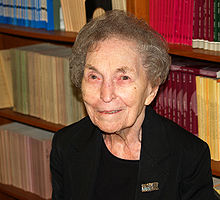Anna Schwartz
| Anna Jacobson Schwartz | |
|---|---|
 |
|
| Born |
November 11, 1915 New York City, New York |
| Died | June 21, 2012 (aged 96) Manhattan, New York |
| Nationality | United States |
| Spouse(s) | Isaac Schwartz (1936–1999, his death) 4 children |
| Institution | National Bureau of Economic Research |
| Field | Monetarism |
| School or tradition |
Chicago school of economics |
| Alma mater |
Barnard College Columbia University |
| Influences | Milton Friedman |
| Contributions | Analysis of money Analysis of banking |
| Information at IDEAS / RePEc | |
Anna Jacobson Schwartz (November 11, 1915 – June 21, 2012) was an American economist at the National Bureau of Economic Research in New York City, and, according to Paul Krugman, "one of the world's greatest monetary scholars." She was best known for her collaboration with Milton Friedman on A Monetary History of the United States, 1867–1960, published in 1963, which laid a large portion of the blame for the Great Depression at the door of the Federal Reserve System. She was also president of the Western Economic Association International in 1988.
Schwartz was born Anna Jacobson on November 11, 1915 in New York City to Pauline (née Shainmark) and Hillel Jacobson. She graduated from Barnard College at 18 and gained her master's degree in economics from Columbia University in 1935, at 19. She started her career as a professional economist one year later.
In 1936, she married Isaac Schwartz, a financial officer and fellow Columbia University graduate, with whom she raised four children. Her first published paper was in the Review of Economics and Statistics (1940), in which she, along with Arthur Gayer and Isaiah Finkelstein, wrote British Share Prices, 1811–1850. She earned her Ph.D. from Columbia in 1964.
In 1941, she joined the staff of the National Bureau of Economic Research. She worked in the New York City office of that organization for the rest of her life. When she joined the National Bureau, it was engaged in the study of business cycles.
Though she held teaching positions for only a short part of her career, she developed younger scholars by her willingness to work with them and to share her approach (a scrupulous examination of the past) to understand history better and to draw lessons for the present.
...
Wikipedia
